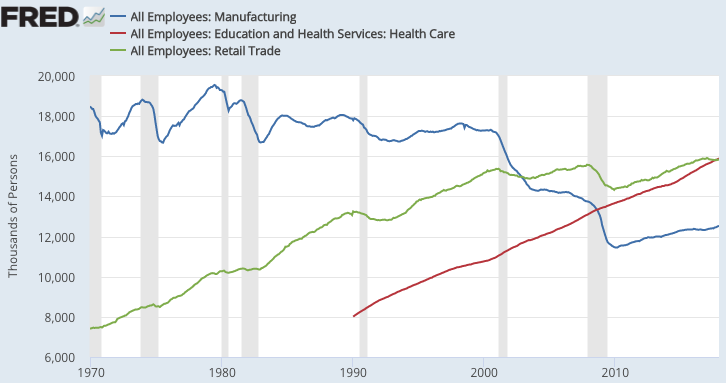- Joined
- Aug 10, 2013
- Messages
- 20,180
- Reaction score
- 21,525
- Location
- Cambridge, MA
- Gender
- Male
- Political Leaning
- Slightly Liberal
No idea how I missed this in January, given that it seems lately I'm always up on my soapbox on this one. But it's a big deal.
Health Care Just Became the U.S.'s Largest Employer
If you're concerned about health care spending, this is the issue that needs to be grappled with:

To date jobs in health care have been relatively safe and reliable. And always, always growing.
Health care is largely un-outsource-able and notoriously sluggish in productivity growth (i.e., it doesn't shed people very often)--which goes back to the point above.
And it's not just doctors or other clinicians, it's regular people working white-collar jobs.
And there's no end in sight.
It's very hard to cut spending when that spending is largely in the form of reliable paychecks to middle class workers, often in towns that don't have a lot of alternative occupational categories.
This is perhaps the predicament of our time. Certainly when it comes to health policy.
Health Care Just Became the U.S.'s Largest Employer
If you're concerned about health care spending, this is the issue that needs to be grappled with:
To date jobs in health care have been relatively safe and reliable. And always, always growing.
This public support makes health-care employment practically invincible, even during the worst downturns. Incredibly, health-care employment increased every month during the Great Recession.
Health care is largely un-outsource-able and notoriously sluggish in productivity growth (i.e., it doesn't shed people very often)--which goes back to the point above.
Third, the two most destabilizing forces for labor in the last generation have been globalization and automation. Together, they have hurt manufacturing and retail by offshoring factories, replacing human arms with robotic limbs, and dooming fusty department stores. But health care is substantially resistant to both. While globalization has revolutionized supply chains and created a global market for manufacturing labor, most health care is local. A Connecticut dentist isn’t selling her services to Portugal, and a physician’s receptionist in Lisbon isn’t directing her patient to Stamford. Health-care work has, so far, been generally resistant to automation, too. While artificial intelligence may one day take over radiology, while programmable robots replace brain surgeons, that future isn’t quite here yet.
And it's not just doctors or other clinicians, it's regular people working white-collar jobs.
Recently, the growth in health-care employment is stemming more from administrative jobs than physician jobs. The number of non-doctor workers in the health industry has exploded in the last two decades. The majority of these jobs aren’t clinical roles, like registered nurses. They are mostly administrative and management jobs, including receptionists and office clerks.
And there's no end in sight.
This isn’t the end of health care’s run. It’s just the beginning. Of the 10 jobs that the Bureau of Labor Statistics projects will see the fastest percent growth in the next decade, five are in health care and elderly assistance. The two fastest-growing occupations—personal-care aides (who perform non-medical duties for older Americans, such as bathing) and home-health aides, (who help the elderly with medical care)—are projected to account for one in every 10 new jobs in that time. The entire health-care sector is projected to account for a third of all new employment.
It's very hard to cut spending when that spending is largely in the form of reliable paychecks to middle class workers, often in towns that don't have a lot of alternative occupational categories.
This is perhaps the predicament of our time. Certainly when it comes to health policy.
